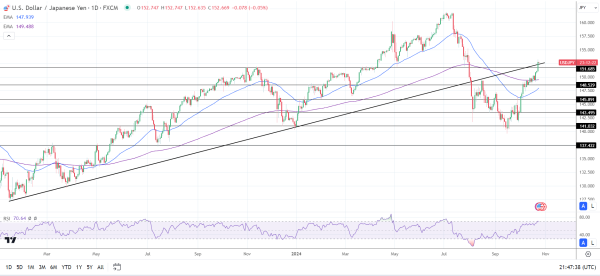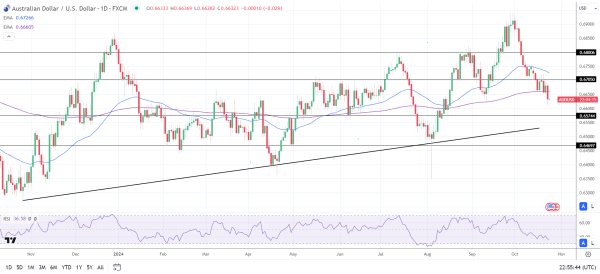Japanese Yen and Australian Dollar News: Services PMIs Put Central Banks on Watch
Japan Services PMI: Will It Shift BoJ’s Rate Path?
On Thursday, October 24, Japan’s private sector PMI numbers will spotlight the USD/JPY pair. The Jibun Bank Services PMI will be the focal point for investors and the Bank of Japan. Economists expect the Services PMI to drop from 53.1 in September to 52.7 in October.
Softer-than-expected service sector activity could dampen investor bets on a Q4 2024 BoJ rate hike. The services sector accounts for over 70% of the Japanese economy. However, investors should also consider subcomponents, including employment and prices.
Bank of Japan Governor Kazuo Ueda recently highlighted the influence of service sector inflation on the BoJ rate path, saying,
“October is a month when service price revisions are concentrated in Japan, so we must scrutinize data carefully.”
An unexpected pickup in service sector activity and higher price trends could drag the USD/JPY below 152 on rising bets on a BoJ Q4 rate hike. Conversely, softer price trends and a weaker-than-expected Services PMI drop could push the USD/JPY toward 153.
Expert Views on Services and the Bank of Japan Rate Path
IMF Japan Mission Chief Nada Choueiri commented on Japan’s inflation trends and BoJ rate path, stating,
“We have seen indicators of consumption starting to increase, and we have seen employees’ scheduled earnings starting to increase, and this is an indication of a positive price-wage cycle working in the economy. This is why we are more confident.”
Despite the optimism toward inflation, Japan’s Mission Chief cautioned that the BoJ should gradually raise interest rates toward neutral.
On Tuesday, the IMF released its quarter growth projections, revising Japan’s growth for 2024 from 0.7% to 0.3%. Weaker growth could force the BoJ to delay interest rate hikes.
Japanese Yen Daily Chart
Later in the Thursday session, US services sector PMI data will influence the USD/JPY. A stronger Services PMI, alongside upward trends in input prices (wage costs) and employment, may drive the USD/JPY pair toward 153.5. Service sector inflation remains the key contributor to headline US inflation. Conversely, softer prices and weaker job creation could pull the USD/JPY below 152.
Beyond the Services PMI, initial jobless claims could influence the Fed rate and US dollar demand. An unexpected spike in claims may boost bets on multiple Q4 2024 Fed rate cuts, possibly supporting a USD/JPY drop below 152.

Private Sector PMIs Bolster Q1 2025 RBA Rate Cut Expectations
On Thursday, Australian service sector PMI numbers drew investor interest, influencing the AUD/USD pair. The Services PMI carried more weight as it accounts for almost 80% of GDP and remained the main contributor to underlying inflation.
The Judo Bank Services PMI increased from 50.5 in September to 50.6 in October. Beyond the Services PMI, price and employment trends could influence the RBA rate path. According to the October survey, input and output price pressures softened in October, while firms hired at the fastest rate five-months.
The upswing in hiring aligned with RBA Deputy Governor Hauser’s comments about tight labor market conditions.
Tighter labor market conditions may boost wage growth and consumer spending, potentially fueling demand-driven inflation. The RBA could maintain the cash rate at 4.35% for longer to dampen private consumption and inflation. Nevertheless, softer prices could dampen the effects of a tighter labor market on the RBA rate path.
Australian Dollar Daily Chart
Later in the session, the US labor market data and services PMI figures will influence the AUD/USD pair. A drop in initial jobless claims and a higher S&P Global Services PMI may pull the AUD/USD below $0.66. Conversely, higher jobless claims and a softer S&P Services PMI could signal a more dovish Fed rate path, potentially driving the AUD/USD toward $0.67.

Keep ahead of the markets with our expert insights. Stay alert to real-time data, central bank views, and expert commentary to adjust your trading strategies accordingly.